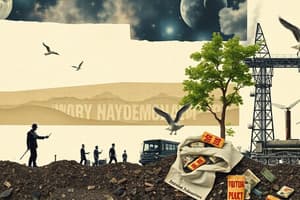Podcast
Questions and Answers
Which of the following is considered a renewable resource?
Which of the following is considered a renewable resource?
- Fossil fuels
- Coal
- Solar energy (correct)
- Natural gas
E-waste includes discarded electronic appliances such as phones and computers.
E-waste includes discarded electronic appliances such as phones and computers.
True (A)
What is the primary purpose of the circular economy?
What is the primary purpose of the circular economy?
To minimize waste and make the most of resources
A large area of marine debris is known as a __________.
A large area of marine debris is known as a __________.
Match the following terms with their definitions:
Match the following terms with their definitions:
Where does most waste end up?
Where does most waste end up?
Provide an example of a location where significant e-waste is generated.
Provide an example of a location where significant e-waste is generated.
Flashcards
What is a resource?
What is a resource?
A material or substance found in the natural environment that can be used by humans for various purposes. Examples include water, air, sunlight, minerals, forests, and fossil fuels.
Types of Resources
Types of Resources
Renewable resources can be replenished naturally over a relatively short period of time. Non-renewable resources are finite and take a very long time to form, so they are considered to be depleted once used.
Product Lifecycle
Product Lifecycle
The process of extracting raw materials, manufacturing a product, distributing and consuming it, and finally disposing of it as waste.
E-waste Landfill in LIC or MIC
E-waste Landfill in LIC or MIC
Signup and view all the flashcards
Garbage Patch
Garbage Patch
Signup and view all the flashcards
Circular Economy
Circular Economy
Signup and view all the flashcards
Extended Producer Responsibility
Extended Producer Responsibility
Signup and view all the flashcards
Study Notes
Defining Resource Types
- Resources are categorized as renewable or non-renewable, natural resources.
Defining Key Terms Related to Waste
- E-waste: Electronic waste.
- Landfills: Sites for waste disposal.
- Garbage patch: Areas of concentrated marine debris, often plastic.
- Plastic pollution: Accumulation of plastic waste in the environment, including microplastics.
- Circular economy: Systems aimed at minimizing waste and maximizing resource use.
- Extended producer responsibility: A system holding producers accountable for the lifecycle of their products.
- 3 Rs (reduce, reuse, recycle): Core principles for waste management.
Essential Questions About Waste
- What is a resource?: Inquiry into the definition and types of resources.
- Effects of production and consumption: Investigation into the environmental impacts of these activities.
- Waste production locations: Identifying where waste is generated.
- Waste disposal routes: Examining where waste ends up and why.
- Waste management strategies: Exploring different approaches to waste management.
Providing Examples of Waste
- Types of resources: Differentiating between renewable and non-renewable resources.
- Product life cycles: Examining the stages of a product's lifecycle.
- Waste management examples: Describing e-waste landfills (low- and middle-income countries) and garbage patches.
Analyzing Waste at Different Scales
- Carbon footprint (individual/country): Measuring the environmental impact of an individual or country's activities.
- Global waste generation: Assessing amounts of waste produced by individuals, households, and countries globally.
- E-waste flow: Tracking the movement of e-waste across the world.
- Effects of e-waste: Analyzing the impacts of e-waste on both human populations and the environment: using Ghana or India as example.
Studying That Suits You
Use AI to generate personalized quizzes and flashcards to suit your learning preferences.




